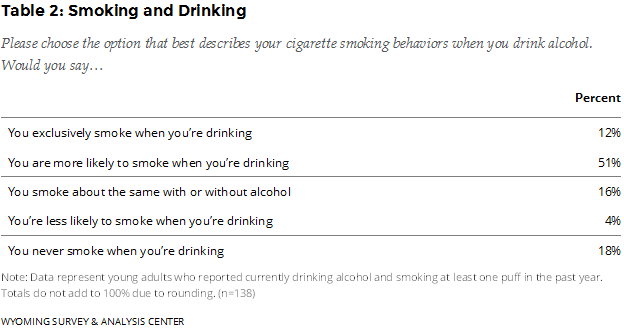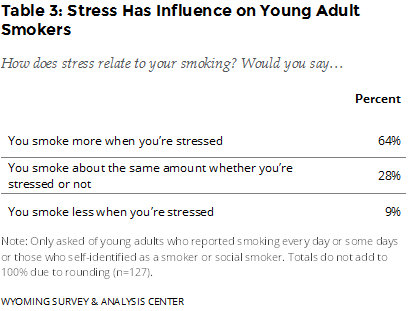Factors Related to Smoking
Drinking and Smoking
 Just over half (51%) of young adults reported currently drinking alcoholic beverages like beer, wine, or liquor. Of this group, 56% were older than the legal drinking age of 21 and 44% were younger. Of young adults who reported currently drinking, half (50%) reported most frequently drinking at home. Bars were the second most reported drinking location (24%), followed by parties (11%). Less than 10% of respondents reported drinking at restaurants, friends’ houses, work, or other locations.
Just over half (51%) of young adults reported currently drinking alcoholic beverages like beer, wine, or liquor. Of this group, 56% were older than the legal drinking age of 21 and 44% were younger. Of young adults who reported currently drinking, half (50%) reported most frequently drinking at home. Bars were the second most reported drinking location (24%), followed by parties (11%). Less than 10% of respondents reported drinking at restaurants, friends’ houses, work, or other locations.
About half of young adults in Wyoming (51%) who had smoked at least once in their lifetime and who reported current alcohol use reported that they were more likely to smoke when they were drinking and another 12% reported that they exclusively smoke when they were drinking (Table 2).
WYSAC examined the relationship between self-described smoking labels and drinking; 58% of self-described social smokers and 49% of self-described smokers reported that they were more likely to smoke when they were drinking.
 Stress and Smoking
Stress and Smoking
The majority (64%) of every day or some-day young adult smokers reported smoking more when they were stressed (Table 3).
Weight and Smoking
Almost all every day or some-day young adult smokers in Wyoming (98%) reported that weight played no role in their choice to start smoking. The YATS asked respondents, “If you planned to quit smoking, how concerned would you be about weight gain?” Most (82%) responded not at all concerned, while less than one in five (18%) responded that they would be very or somewhat concerned about weight gain.
Discussion
The overall prevalence of tobacco use among young adults in Wyoming is comparable to the general population. Young men, those who identify as LGBT, and those not attending school smoke cigarettes at higher rates than their counterparts. Eliminating disparities in tobacco use for these groups will lead to health equity (CDC, 2015).
Confirming our original hypothesis, many young adults consider themselves social smokers and are more likely to smoke while drinking alcohol. There is also a strong relationship between stress and smoking. Tobacco prevention efforts focused on reducing these associations could ultimately lead to a reduction in tobacco consumption.
In general, young adults in Wyoming perceive cigarette smoking as socially unacceptable and risky to people’s health, which suggests an anti-cigarette social norm. However, three groups (smokers, young men, and those not attending school) were generally more likely to perceive smoking as socially acceptable. They were also less likely to see them as risky. Educating these groups could change social norms even more.
While most young adults in Wyoming do not currently use ENDS, current, former, and experimental smokers are more likely to try ENDS and become regular users, compared to never smokers. Former smokers were more likely to report using ENDS every day more frequently than current smokers and experimental smokers. Most ENDS users reported trying them for the first time because they wanted to try something new, they were curious, or they tried them as part of a social activity. While most young adults perceive some health risk of using ENDS, fewer young adults see ENDS as risky compared to seeing cigarettes as risky. When working to change prevalence rates, tobacco prevention and control efforts should include a focus on ENDS as well as cigarettes.

